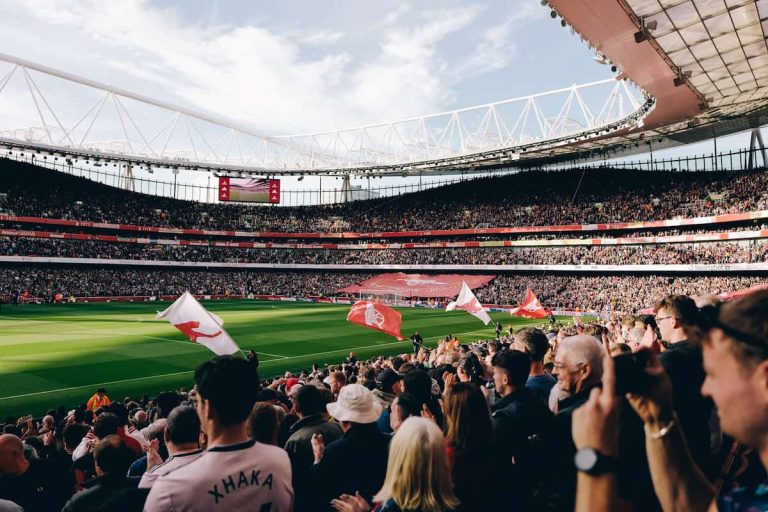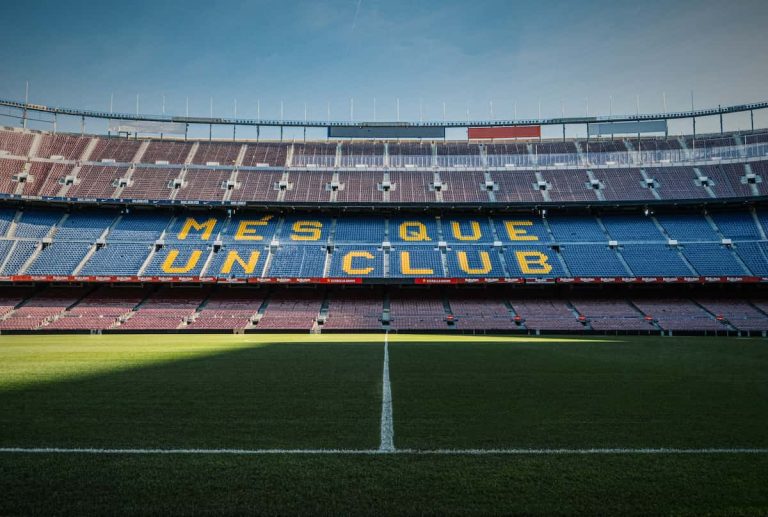Is the MLS a Retirement League?

Ever since David Beckham’s famous move to LA Galaxy in 2007, football enthusiasts have asked the question ‘Is the MLS a retirement league?’. Fast-forward to 2023 and this question is being asked more often as the likes of Lionel Messi, Sergio Busquets, Jordi Alba and more make their moves to America’s top flight.
At the age of 36, Lionel Messi joins Beckham’s Inter Miami squad in the latter stages of his career, and this further strengthens the argument that players from Europe’s top 5 leagues move to the MLS for a payout and a slower pace of play. In this article, we discuss this topic in detail discussing the origin of the retirement league label, the MLS vs other top leagues, the role of designated players and more. Read on to learn all about it.
Table of Contents
Is the MLS a Retirement League?
The MLS has been labelled a retirement league ever since David Beckham’s move to LA Galaxy in 2007. The reason older, high profile players are attracted to America’s top flight is because of the high salaries on offer and the lower intensity of the matches, helping them to play for longer at an older age.
The Origin of the “Retirement League” Label
So where did the “retirement league” label originate from with regard to the MLS? Well, America’s top flight most notably started attracting high profile ageing players when Englishman David Beckham signed for LA Galaxy in 2007.
Although Columbian superstar Carlos Valderrama signed for Tampa Bay Mutiny in 1995, fans didn’t really start taking notice of high profile players signing for MLS sides until Beckham’s arrival. Some great examples of “retirement league” players who joined the MLS are Andrea Pirlo, Kaká, Bastian Schweinsteiger, David Villa, Frank Lampard and Steve Gerrard.
When pundits, fans and journalists started to recognise that top footballers approaching the end of their careers were heading to the MLS, this is when the “retirement league” label started to be thrown about.
Why Do Older Players Go to the MLS?
There are two main reasons why older players sign for clubs in the MLS, and these are high salaries, the lower intensity, and the opportunity to play more matches.
High Salaries
The main reason why older, high profile players sign for MLS clubs is because they are more likely to receive a higher wage later on in their careers than if they were to stay in one of Europe’s top five leagues.
When players get into their mid-to-late thirties, clubs in the top 5 leagues are less likely to offer good wages and long contracts, as players at that age will become less influential in leagues that demand stronger physicality.
By moving to the MLS, older players can bank themselves a really impressive salary to play in a competition where they can still have a lot of influence on matches due to its lower intensity.
Less Intensity
As players become older, they’re unable to run as fast or for as long, which means the demands of the top leagues can become too much for their bodies. By moving to the MLS where the intensity is lower, their bodies can better handle the demands of the football being played. This means they can enjoy playing football for longer, without putting themselves at a higher risk of getting injured.
The Opportunity to Play More Matches
The final reason why players move to the MLS is to seek the opportunity to play more matches. As players become older in top European sides, their opportunities for minutes may start to dwindle.
By moving to the MLS where the standard is a lot lower, they’re more likely to play more matches, which can be a big factor for players when making the decision of whom to sign for next.
Analysis of Current Player Ages
We’re going to have a look at the current player ages in the MLS to help us decipher whether the league is home to too many retirement players.
Average Age of MLS Players During the 2022/23 Season
Here are the average ages of MLS squads during the most recent season:
|
Club |
Average squad age |
|
New York Red Bulls |
23.7 |
|
New York City FC |
24.0 |
|
CF Montréal |
24.1 |
|
St. Louis City SC |
24.7 |
|
FC Dallas |
25.2 |
|
Vancouver Whitecaps FC |
25.3 |
|
Atlanta United FC |
25.3 |
|
Columbus Crew |
25.4 |
|
Inter Miami CF |
25.6 |
|
Orlando City SC |
25.8 |
|
Philadelphia Union |
25.8 |
|
FC Cincinnati |
26.0 |
|
Real Salt Lake City |
26.1 |
|
Houston Dynamo FC |
26.2 |
|
Colorado Rapids |
26.2 |
|
Chicago Fire FC |
26.3 |
|
Charlotte FC |
26.3 |
|
Toronto FC |
26.3 |
|
LA Galaxy |
26.4 |
|
San Jose Earthquakes |
26.5 |
|
New England Revolution |
26.5 |
|
Los Angeles FC |
26.5 |
|
Minnesota United FC |
26.8 |
|
Portland Timbers |
27.4 |
|
D.C. United |
27.5 |
|
Seattle Sounders FC |
27.5 |
|
Austin FC |
27.9 |
|
Sporting Kansas City |
28.1 |
|
Nashville SC |
29.1 |
Data taken from Transfermarkt
The average squad age out of the 29 MLS clubs is 26.4 years old. To put things in perspective, Premier League club Arsenal had the youngest team among the world’s top ten football clubs during the 2022/23 season, with an average age of 25.2 years old.
Is the MLS a retirement league? This data could argue not. With clubs like New York Red Bulls, famous for signing Thierry Henry towards the end of his career, having an average squad age of 23.7 years old, they’re very much proving that some MLS teams are prioritising investment in youth over older signings.
On the other hand, Nashville SC had the oldest average aged squad, which was 29.1 years old for the 2022/23 season. Their two designated players are Hany Mukhtar and Walker Zimmerman, who are 28 and 30. This probably explains that the MLS presents a broad spectrum of squad age management strategies, which is similar to major leagues including the Premier League, La Liga and Bundesliga.
Role of Designated Players
When discussing whether the MLS is a retirement league, we have to consider the ‘Designated Player Rule’. The reason for this is that the designated player rule allows MLS sides to sign up to three designated players who can be paid a salary that sits outside their salary cap.
The types of players that have given the MLS a retirement league label have tended to be designated players, as they have moved to the league on high wages outside the salary cap, which has provided a good payout towards the end of their careers.
The designated player rule is often referred to as the “David Beckham Rule” which proves how much of an influence the English midfielder had on American soccer. The rule was created for the league so that they could start attracting high-profile players with big wages.
MLS vs. Other Top Leagues
Another area to analyse when deciding whether the MLS is a retirement league is comparing the competition against European major leagues and also the Saudi Pro League.
MLS vs Europe Major Leagues
When comparing the MLS to European major leagues, the idea of a European league being classed as a retirement league seems unrealistic. This mainly comes down to the speed and intensity of those leagues in comparison to American soccer.
The MLS is slower and less intense than the top 5 European leagues (Premier League, La Liga, Bundesliga, Serie A and Ligue 1) and this makes it a suitable destination for players approaching retirement when their bodies are starting to age and slow down.
A player in their late thirties would have to be in elite shape in order to be able to play the majority of a season in England’s top tier, which is recognised for being a fast and physically intense competition.
With European teams challenging for some of the greatest titles in world football, including the Champions League and the Europa League, players in their prime are more attracted to playing in Europe when they can handle the intensity of the biggest competitions in football. Furthermore, this is when their desire and hunger will be at its peak.
MLS vs Saudi Pro League
After Cristiano Ronaldo signed for Al Nassr in 2023, the Saudi Pro League has been poaching lots of high-profile footballers from Europe by offering them lucrative contracts. Ronaldo would represent a “retirement league” signing, as the player moved to Saudi Arabia at the age of 38.
His signing was the catalyst for a number of other high profile moves to Saudi Arabia, including Karim Benzema and N’Golo Kanté. With this growing trend, there’s a high chance in the near future that the Saudi Pro League claims the title of being the main retirement league from the MLS.
Future Outlook for the MLS
When assessing the future outlook for the MLS, and its retirement league label, it almost entirely dependent on the movements of the Saudi Pro League. Although lots of older, high profile players have signed for Inter Miami in the MLS in 2023, many other players are opting to move to Saudi Arabia instead.
Can the MLS compete with the Saudi Pro League financially? It’s looking unlikely, and if that’s the case, the Saudi Pro League will be sure to claim the retirement league claim. If older players keep opting to move to Saudi Arabia, the average age of MLS squads could reduce, and it will become harder for the MLS to recruit the high level of “designated players” that it is used to.
However, with Apple’s recent investment in MLS broadcasting and Lionel Messi’s move to Inter Miami, as well as the 2024 Copa América and 2026 World Cup being held in America, it could be the start of a somewhat boom in American domestic football.
Conclusion
Is the MLS a retirement league? Although the MLS has been labelled a retirement league for many years since 2007, there could be a turn in the tide with the recent movements of the Saudi Pro League.
It’s not clear whether Apple’s investment in the MLS will help American clubs compete with Saudi clubs in terms of finances, but if so, there could be two retirement leagues that high profile players can make moves to.
Past analysis tells us that plenty of older players have taken up moves to the MLS, however the average age of the squads in the league needs further analysis to truly work out whether the MLS should be considered a retirement league.
Related Articles
Frequently Asked Questions
-
How Many US Football Players Play in Europe?
With the consistent rise in quality of US soccer players, there are more and more US players playing football in Europe. Players such as Christian Pulisic, Giovanni Reyna and Tyler Adams have played in some of the top European Leagues including the Premier League, Bundesliga and Serie A.






